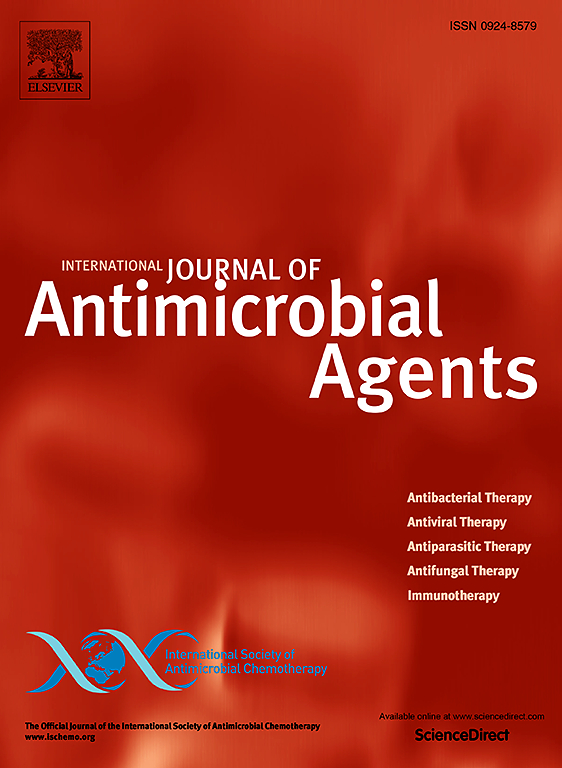优化利奈唑胺治疗肾损害危重患者院内尿路感染的剂量。
IF 4.6
2区 医学
Q1 INFECTIOUS DISEASES
International Journal of Antimicrobial Agents
Pub Date : 2025-09-05
DOI:10.1016/j.ijantimicag.2025.107610
引用次数: 0
摘要
背景:本研究探讨了利奈唑胺(LNZ)在肾脏损害和院内多重耐药革兰氏阳性尿路感染(uti)危重患者的尿药代动力学和药效学(PK/PD)。目的是解决有限的治疗选择和不确定的尿排泄所带来的治疗挑战,建立优化的剂量策略。方法:对ICU肾损害患者进行前瞻性观察研究。分析LNZ血浆、尿浓度和尿量,建立半机械性人群PK模型。模拟评估基于PK/PD靶点(AUC24/MIC≥80)和毒性阈值(Css,min≥8mg /L)的给药方案。结果:血浆/膀胱尿关节模型描述了20例危重患者(中位年龄85岁,APACHE-II 20岁)398份血浆/尿液样本的PK。估计清除率:非肾(CLNR) 4.9 L/h,肾(CLR) 0.261 L/h,尿(CLU) 0.062 L/h。在eGFR为30 mL/min/1.73m²时,肾脏排泄占剂量的5%。尿LNZ暴露随eGFR增加而增加;年龄显著增加了血浆暴露。模拟显示,600 mg Q12h对eGFR达到了足够的尿暴露,但对eGFR没有达到15-60 mL/min/1.73m²。结论:肾功能与LNZ尿暴露呈正相关。除eGFR < 15 mL/min/1.73 m²者外,标准LNZ 600 mg Q12h适用于治疗肾损害患者的尿路感染。使用延长输注可能有助于减轻毒性的风险,同时保持尿暴露。本文章由计算机程序翻译,如有差异,请以英文原文为准。

Optimizing linezolid dosing for nosocomial urinary tract infections in critically ill patients with renal impairment
Background
This study characterized the urinary pharmacokinetics and pharmacodynamics (PK/PD) of linezolid (LNZ) in critically ill patients with renal impairment and nosocomial multidrug-resistant Gram-positive urinary tract infections (UTIs). The aim was to address therapeutic challenges arising from limited treatment options and uncertain urinary excretion, to establish optimized dosing strategies.
Methods
A prospective observational study was conducted in ICU patients with renal impairment. LNZ plasma and urine concentration and urine volume were analyzed to develop semi-mechanistic population PK model. Simulations evaluated dosing regimens based on PK/PD target (AUC24/MIC ≥ 80) and toxicity threshold (Css,min ≥ 8 mg/L).
Results
A plasma/bladder urine joint model described PK in 20 critically ill patients (median age 85, APACHE-II 20) using 398 plasma/urine samples. Estimated clearances: non-renal (CLNR) 4.9 L/h, renal (CLR) 0.261 L/h, urine (CLU) 0.062 L/h. Renal excretion accounted for 5% of the dose at eGFR 30 mL/min/1.73m². Urinary LNZ exposure increased with eGFR; age significantly increased plasma exposure. Simulations indicated 600 mg Q12h achieved sufficient urinary exposure for eGFR 15–60 mL/min/1.73m², but not for eGFR <15 mL/min/1.73m². Lower eGFR correlated with higher plasma toxicity risk.
Conclusions
Renal function was positively associated with LNZ urinary exposure. The standard LNZ 600 mg Q12h was appropriate for treating UTIs in renal impairment patients, except for those with eGFR <15 mL/min/1.73 m². The use of extended infusion may help mitigate the risk of toxicity while maintaining urinary exposure.
求助全文
通过发布文献求助,成功后即可免费获取论文全文。
去求助
来源期刊
CiteScore
21.60
自引率
0.90%
发文量
176
审稿时长
36 days
期刊介绍:
The International Journal of Antimicrobial Agents is a peer-reviewed publication offering comprehensive and current reference information on the physical, pharmacological, in vitro, and clinical properties of individual antimicrobial agents, covering antiviral, antiparasitic, antibacterial, and antifungal agents. The journal not only communicates new trends and developments through authoritative review articles but also addresses the critical issue of antimicrobial resistance, both in hospital and community settings. Published content includes solicited reviews by leading experts and high-quality original research papers in the specified fields.

 求助内容:
求助内容: 应助结果提醒方式:
应助结果提醒方式:


